Electric Guitars Market: Current Analysis and Forecast (2024-2032)
Emphasis on Product Type (Solid Body Guitar, Semi-hollow Body Guitars, Hollow Body Guitars, and Others); Distribution Channel (Online and Offline); and Region/Country
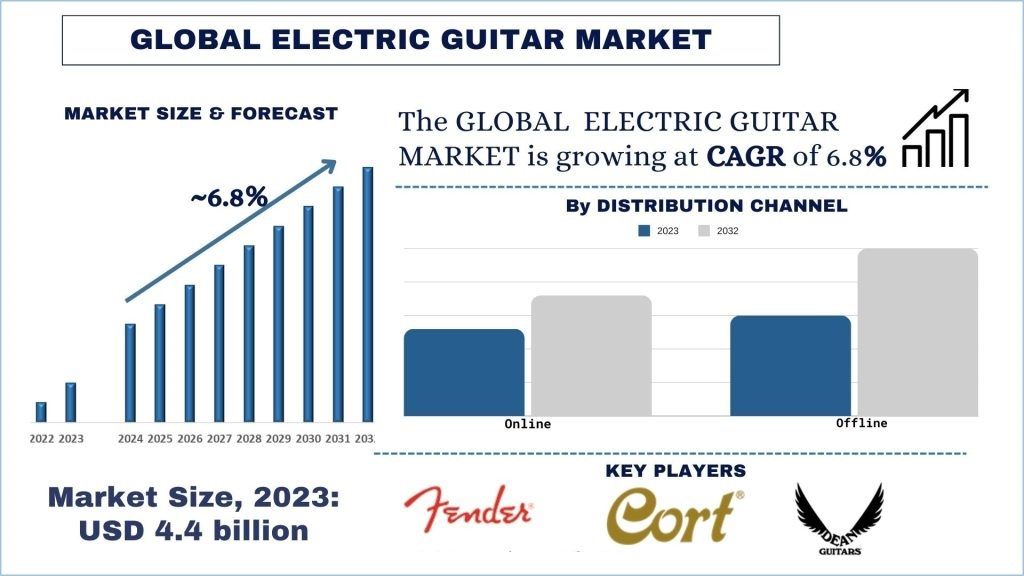
Electric Guitar Market Size & Forecast
The electric guitar market was valued at approximately ~USD 4.4 Million and is expected to grow at a strong CAGR of around 6.8% during the forecast period (2024-2032) owing to the rising demand for musical instruments.
Electric Guitar Market Analysis
The electric guitar market is a dynamic and multifaceted sector driven by innovation, creativity, and a passion for music. Despite evolving market dynamics and changing consumer preferences, the enduring appeal of the electric guitar as a versatile and iconic instrument ensures its continued relevance and significance in the music industry. The market is expected to expand as people increasingly prioritize options that drive sustainability and increase usability for the optimal playing experience at present. Also, company collaborations and innovative product launches drive the industry’s growth.
For instance, in May 2024, Electric Guitar PLC acquired 3radical Limited. This company utilizes its Software as a Service platform, 3radical Voco, to enable organizations to engage individuals and request their data directly using interactive digital experiences.
Moreover, in January 2024, Martin & Co. launched the all-new GPCE Inception Maple, a sonic beauty of sustainable tonewoods. It is made from sustainable tonewoods, including an FSC-certified European spruce top, maple sides, and an eye-catching three-piece back of maple and black walnut.
Also, in August 2023, Fender launched a new collection of sustainable guitars in California Streetwoods collection which were made from trees which were safely removed in California.
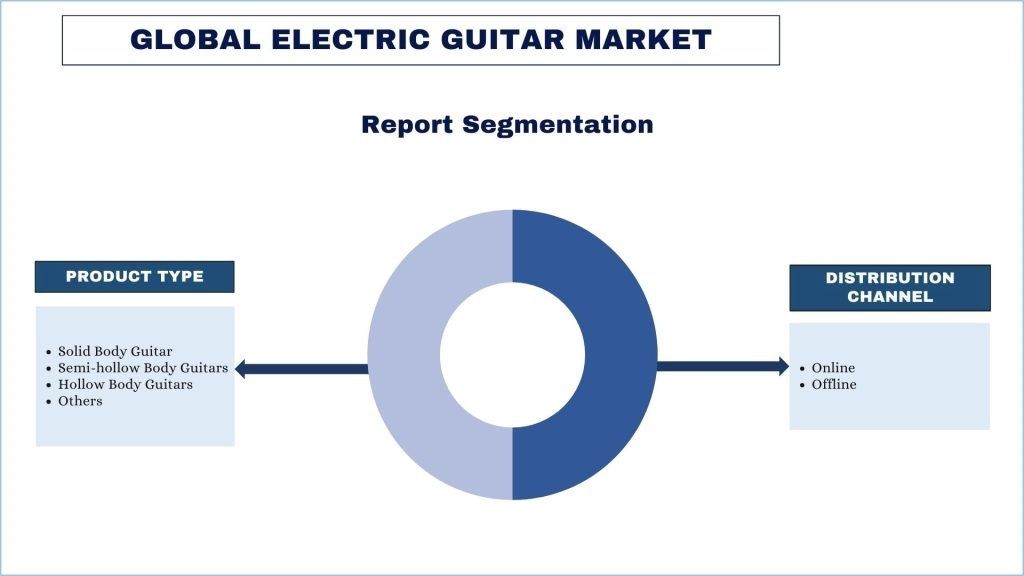
Electric Guitar Market Trends
This section discusses the key market trends that are influencing the various segments of the Electric Guitar Market as identified by our team of research experts.
Semi-hollow Body Guitars Segment Transforming Industry
The semi-hollow body guitars segment in the electric guitar market has seen steady growth over the years, driven by various factors. Semi-hollow body guitars feature a combination of a solid center block running through the body and hollow wings or chambers on either side. This design balances the warm, resonant tone of a hollow-body guitar and the sustained and reduced feedback of a solid-body guitar. The solid center block provides stability and reduces feedback, especially at high volumes or when using distortion. The hollow wings or chambers contribute to the guitar’s overall tone, adding depth and resonance. The F-holes, common on semi-hollow guitars, also aid resonance and projection. Semi-hollow body guitars are prized for their versatility. They can produce a wide range of tones, from warm jazz to gritty blues and rock sounds. It has more warmth and resonance than a solid body guitar, offering good sustain and clarity. This makes it suitable for various musical genres and playing styles. Semi-hollow body guitars typically have a comfortable, ergonomic design. They’re often lighter than solid-body guitars, making them easier to play for extended periods. The semi-hollow construction also adds a bit of acoustic-like responsiveness to the instrument, making it enjoyable to play acoustically and plugged in. Semi-hollow body electric guitars offer a compelling combination of tone, versatility, and playability, making them popular among musicians seeking a well-rounded instrument for various musical applications. Rising product advancements are leading to the market’s growth of semi-hollow electric guitars. For instance, in December 2021, Harmony announced the arrival of the H72 Reissue, an affordable update of one of its classic semi-hollow electric guitar models, the original H72 first launched in 1966.
North America is Expected to Grow with Significant CAGR During Forecast Period
Within North America, the U.S. holds a major share of the market. The region’s rapid urbanization, rising investments in the music industry, the growing trend of musical instruments owing to the popularity of music, innovative product launches, and the presence of several market players are the major factors boosting the market’s growth in the country.
- In February 2024, S.-based PRS’s latest affordable SE range member, the new PRS SE CE 24 Standard Satin, is the brand’s cheapest guitar yet and brings the SE line’s class-leading build quality, playability, and sound into true entry-level territory.
- In January 2024, S.-based EVH announced the debut of the SA-126 model, Wolfgang Van Halen’s signature guitar, resulting from a 3-year collaborative development process between Wolfgang, Matt Bruck, and EVH’s Masterbuilder Chip Ellis.
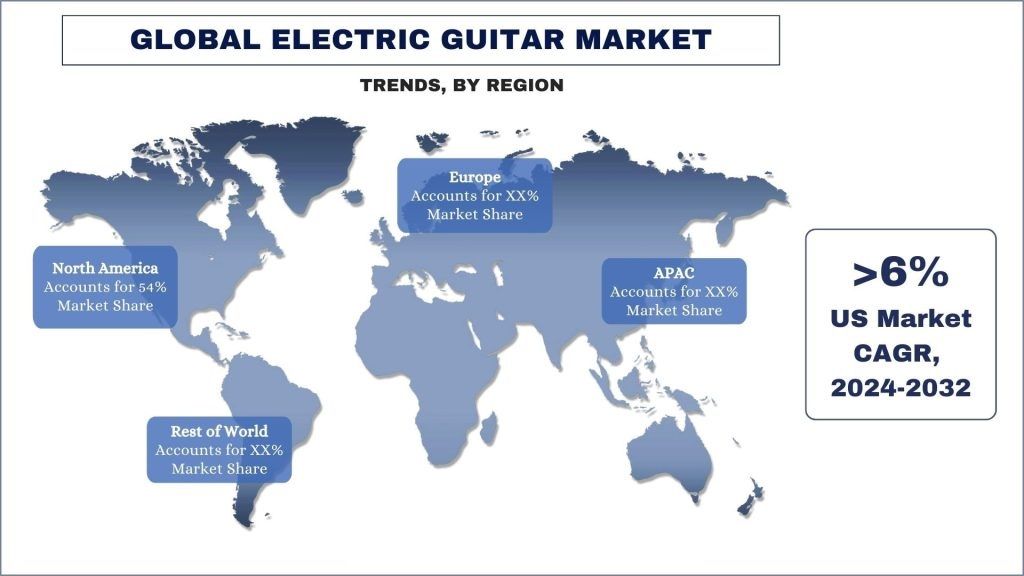
Electric Guitars Market trends
Electric Guitar Industry OverviewThe electric guitar market is competitive, with the presence of several global and international market players. The key players are adopting different growth strategies to enhance their market presence, such as partnerships, agreements, collaborations, new type launches, geographical expansions, and mergers and acquisitions. Some of the major players operating in the market are Gibson Brands, Inc.; Fender Musical Instruments Corporation; Karl Höfner GmbH & Co. KG; Ibanez Guitars; Yamaha Corporation; The ESP Guitar Company; Cort Guitars; Michael Kelly Guitar Co.; DEAN GUITARS; PRS Guitars.
Electric Guitar Market News
- In October 2023, S.-based Gibson launched a new line of lightweight Les Pauls that offer a fresh, stripped-down take on the storied single-cut electric guitar and a more affordable one.
- In September 2023, LAVA Music launched its new LAVA ME 4 lineups of ‘smart’ acoustic-electric guitars, featuring a powerful new DSP system running onboard effects. The new operating system has new apps for online jamming, interactive learning, 24-bit recording, and new effects presets. Also new is a truss rod for adjusting string height, longer battery life, and wireless foot pedals. The guitars come in carbon fiber, spruce-top, laminate body versions, and various colors.
- In August 2023,S.-based Artiphon launched a new “all-in-one instrument” called the Chorda. Built using the brand’s “multi-instrument” technology, the Chorda is designed for making music on the go and incorporates guitar, piano, drums, synths, and more instruments into the same interface. The Chorda can be played like a keyboard or drum machine or strummed like a guitar using the “smart strum” feature.
Electric Guitar Market Report Coverage
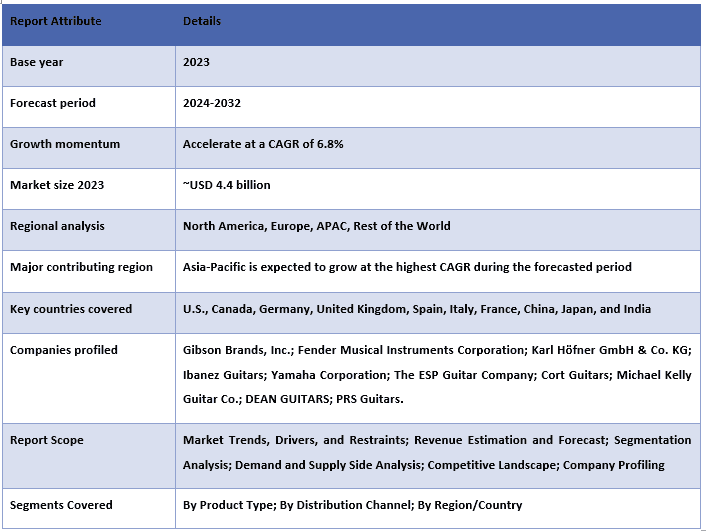
Electric Guitar Market Report Coverage
Reasons to buy this report:
- The study includes market sizing and forecasting analysis validated by authenticated key industry experts.
- The report presents a quick review of overall industry performance at one glance.
- The report covers an in-depth analysis of prominent industry peers with a primary focus on key business financials, type portfolios, expansion strategies, and recent developments.
- Detailed examination of drivers, restraints, key trends, and opportunities prevailing in the industry.
- The study comprehensively covers the market across different segments.
- Deep dive regional level analysis of the industry.
Customization Options:
The global electric guitar market can further be customized as per the requirement or any other market segment. Besides this, UMI understands that you may have your own business needs, hence feel free to connect with us to get a report that completely suits your requirements.
Table of Contents
Research Methodology for the Electric Guitar Market Analysis (2024-2032)
Analyzing the historical market, estimating the current market, and forecasting the future market of the global electric guitar market were the three major steps undertaken to create and analyze the adoption of electric guitar in major regions globally. Exhaustive secondary research was conducted to collect the historical market numbers and estimate the current market size. Secondly, to validate these insights, numerous findings and assumptions were taken into consideration. Moreover, exhaustive primary interviews were also conducted, with industry experts across the value chain of the global electric guitar market. Post assumption and validation of market numbers through primary interviews, we employed a top-down/bottom-up approach to forecasting the complete market size. Thereafter, market breakdown and data triangulation methods were adopted to estimate and analyze the market size of segments and sub-segments of the industry pertains to. Detailed methodology is explained below:
Analysis of Historical Market Size
Step 1: In-Depth Study of Secondary Sources:
Detail secondary study was conducted to obtain the historical market size of the electric guitar market through company internal sources such as annual reports & financial statements, performance presentations, press releases, etc., and external sources including journals, news & articles, government publications, competitor publications, sector reports, third-party database, and other credible publications.
Step 2: Market Segmentation:
After obtaining the historical market size of the electric guitar market, we conducted a detailed secondary analysis to gather historical market insights and share for different segments & sub-segments for major regions. Major segments are included in the report as product type, distribution channel, and regions. Further country-level analyses were conducted to evaluate the overall adoption of testing models in that region.
Step 3: Factor Analysis:
After acquiring the historical market size of different segments and sub-segments, we conducted a detailed factor analysis to estimate the current market size of the electric guitar market. Further, we conducted factor analysis using dependent and independent variables such as product type, distribution channel, and regions of the electric guitar market. A thorough analysis was conducted for demand and supply-side scenarios considering top partnerships, mergers and acquisitions, business expansion, and type launches in the electric guitar market sector across the globe.
Current Market Size Estimate & Forecast
Current Market Sizing: Based on actionable insights from the above 3 steps, we arrived at the current market size, key players in the global electric guitar market, and market shares of the segments. All the required percentage shares split, and market breakdowns were determined using the above-mentioned secondary approach and were verified through primary interviews.
Estimation & Forecasting: For market estimation and forecast, weights were assigned to different factors including drivers & trends, restraints, and opportunities available for the stakeholders. After analyzing these factors, relevant forecasting techniques i.e., the top-down/bottom-up approach were applied to arrive at the market forecast for 2030 for different segments and sub-segments across the major markets globally. The research methodology adopted to estimate the market size encompasses:
- The industry’s market size, in terms of revenue (USD) and the adoption rate of the electric guitar market across the major markets domestically
- All percentage shares, splits, and breakdowns of market segments and sub-segments
- Key players in the global electric guitar market in terms of types offered. Also, the growth strategies adopted by these players to compete in the fast-growing market
Market Size and Share Validation
Primary Research: In-depth interviews were conducted with the Key Opinion Leaders (KOLs) including Top Level Executives (CXO/VPs, Sales Head, Marketing Head, Operational Head, Regional Head, Country Head, etc.) across major regions. Primary research findings were then summarized, and statistical analysis was performed to prove the stated hypothesis. Inputs from primary research were consolidated with secondary findings, hence turning information into actionable insights.
Split of Primary Participants in Different Regions
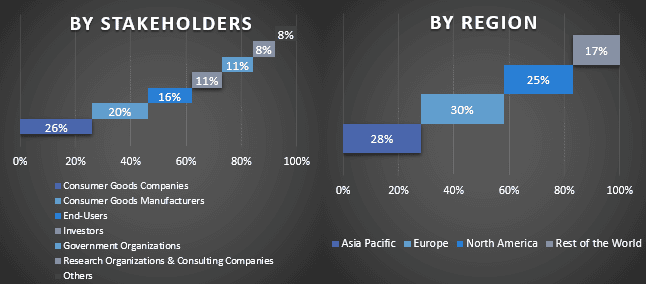
Market Engineering
The data triangulation technique was employed to complete the overall market estimation and to arrive at precise statistical numbers for each segment and sub-segment of the global electric guitar market. Data was split into several segments & sub-segments post studying various parameters and trends in the areas of the product type, distribution channel, and regions in the global electric guitar market.
The main objective of the Global Electric Guitar Market Study
The current & future market trends of the global electric guitar market were pinpointed in the study. Investors can gain strategic insights to base their discretion for investments on the qualitative and quantitative analysis performed in the study. Current and future market trends determined the overall attractiveness of the market at a regional level, providing a platform for the industrial participant to exploit the untapped market to benefit from a first-mover advantage. Other quantitative goals of the studies include:
- Analyze the current and forecast market size of the electric guitar market in terms of value (USD). Also, analyze the current and forecast market size of different segments and sub-segments.
- Segments in the study include areas of the product type, distribution channel, and regions.
- Define and analysis of the regulatory framework for the electric guitar
- Analyze the value chain involved with the presence of various intermediaries, along with analyzing customer and competitor behaviors of the industry.
- Analyze the current and forecast market size of the electric guitar market for the major region.
- Major countries of regions studied in the report include Asia Pacific, Europe, North America, and the Rest of the World
- Company profiles of the electric guitar market and the growth strategies adopted by the market players to sustain in the fast-growing market.
- Deep dive regional level analysis of the industry
Frequently Asked Questions FAQs
Q1: What is the electric guitar market's current market size and growth potential?
Q2: What are the driving factors for the growth of the electric guitar market?
Q3: Which segment has the largest share of the electric guitar market by product type?
Q4: What are the emerging technologies and trends in the electric guitar market?
Q5: Which region will dominate the electric guitar market?
Related Reports
Customers who bought this item also bought










